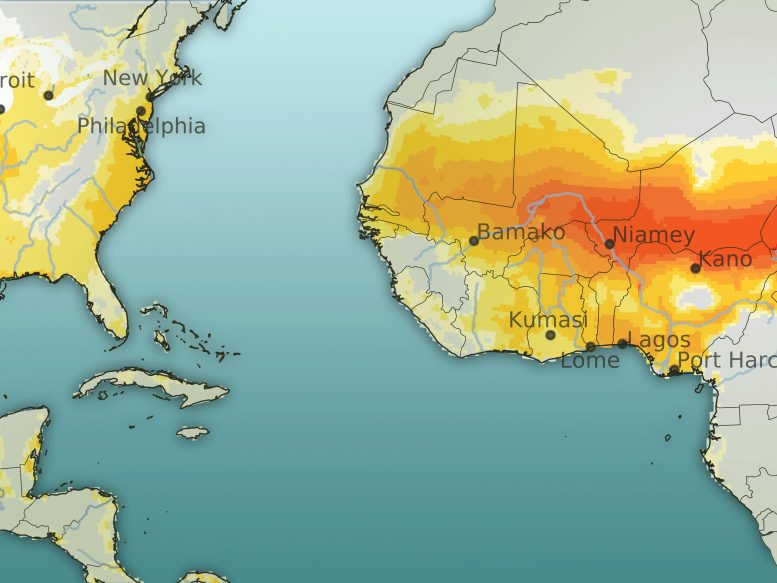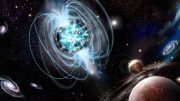
If global temperatures rise by 1°C or more, billions will face extreme heat and humidity, hindering natural cooling, according to new research. Exceeding 1.5°C above preindustrial levels will drastically impact human health, as humans have limits to how much heat and humidity they can tolerate.
A rise of 1 degree Celsius (C) or more in global temperatures from present levels will put billions at risk of experiencing extreme heat and humidity, making natural body cooling impossible, according to interdisciplinary research from the Penn State College of Health and Human Development, Purdue University College of Sciences and Purdue Institute for a Sustainable Future.
Results from a new article recently published in the journal Proceedings of the National Academy of Sciences indicated that warming of the planet beyond 1.5 C above preindustrial levels will be increasingly devastating for human health across the planet.
Humans can only withstand certain combinations of heat and humidity before their bodies begin to experience heat-related health problems, such as heat stroke or heart attack. As climate change pushes temperatures higher around the world, billions of people could be pushed beyond these limits.
Since the start of the Industrial Revolution, when humans began to burn fossil fuels in machines and factories, temperatures around the world have increased by about 1 C, or 1.8 degrees Fahrenheit (F). In 2015, 196 nations signed the Paris Agreement which aims to limit worldwide temperature increases to 1.5 C above pre-industrial levels.

This composite map shows land areas that could face extreme heat if the planet continues to warm (indicated in yellow and orange). The darker the color, the longer the projected exposure to extreme heat. Credit: Courtesy of Daniel Vecellio, Qinqin Kong, W. Larry Kenney and Matthew Huber; composite image by Dennis Maney, Penn State
The research team modeled global temperature increases ranging between 1.5 C and 4 C — considered the worst-case scenario where warming would begin to accelerate — to identify areas of the planet where warming would lead to heat and humidity levels that exceed human limits.
“To understand how complex, real-world problems like climate change will affect human health, you need expertise both about the planet and the human body,” said co-author W. Larry Kenney, professor of physiology and kinesiology, the Marie Underhill Noll Chair in Human Performance at Penn State and co-author of the new study. “I am not a climate scientist, and my collaborators are not physiologists. Collaboration is the only way to understand the complex ways that the environment will affect people’s lives and begin to develop solutions to the problems that we all must face together.”
A threat to billions
The ambient wet-bulb temperature limit for young, healthy people is about 31 C, which is equal to 87.8 F at 100% humidity, according to work published last year by Penn State researchers. However, in addition to temperature and humidity, the specific threshold for any individual at a specific moment also depends on their exertion level and other environmental factors, including wind speed and solar radiation. In human history, temperatures and humidity that exceed human limits have been recorded only a limited number of times — and only for a few hours at a time — in the Middle East and Southeast Asia, according to the researchers.
Results of the study indicate that if global temperatures increase by 2 C above pre-industrial levels, the 2.2 billion residents of Pakistan and India’s Indus River Valley, the one billion people living in eastern China, and the 800 million residents of sub-Saharan Africa will annually experience many hours of heat that surpass human tolerance.
These regions would primarily experience high-humidity heat waves. Heatwaves with higher humidity can be more dangerous because the air cannot absorb excess moisture, which limits sweat evaporation from human bodies and moisture from some infrastructure, like evaporative coolers. Troublingly, researchers said, these regions are also in lower-to-middle-income nations, so many of the affected people may not have access to air conditioning or any effective way to mitigate the negative health effects of the heat.
If warming of the planet continues to 3 C above pre-industrial levels, the researchers concluded, heat and humidity levels that surpass human tolerance would begin to affect the Eastern Seaboard and the middle of the United States — from Florida to New York and from Houston to Chicago. South America and Australia would also experience extreme heat at that level of warming.
At current levels of heating, the researchers said, the United States will experience more heatwaves, but these heatwaves are not predicted to surpass human limits as often as in other regions of the world. Still, the researchers cautioned that these types of models often do not account for the worst, most unusual weather events.
“Models like these are good at predicting trends, but they do not predict specific events like the 2021 heatwave in Oregon that killed more than 700 people or London reaching 40 C last summer,” said lead author Daniel Vecellio, a bioclimatologist who completed a postdoctoral fellowship at Penn State with Kenney. “And remember, heat levels then were all below the limits of human tolerance that we identified. So, even though the United States will escape some of the worst direct effects of this warming, we will see deadly and unbearable heat more often. And — if temperatures continue to rise — we will live in a world where crops are failing and millions or billions of people are trying to migrate because their native regions are uninhabitable.”
Understanding human limits and future warming
Over the last several years, Kenney and his collaborators have conducted 462 separate experiments to document the combined levels of heat, humidity, and physical exertion that humans can tolerate before their bodies can no longer maintain a stable core temperature.
“As people get warmer, they sweat, and more blood is pumped to their skin so that they can maintain their core temperatures by losing heat to the environment,” Kenney said. “At certain levels of heat and humidity, these adjustments are no longer sufficient, and body core temperature begins to rise. This is not an immediate threat, but it does require some form of relief. If people do not find a way to cool down within hours, it can lead to heat exhaustion, heat stroke, and strain on the cardiovascular system that can lead to heart attacks in vulnerable people.”
In 2022, Kenney, Vecellio, and their collaborators demonstrated that the limits of heat and humidity people can withstand are lower than were previously theorized.
“The data collected by Kenney’s team at Penn State provided much-needed empirical evidence about the human body’s ability to tolerate heat. Those studies were the foundation of these new predictions about where climate change will create conditions that humans cannot tolerate for long,” said co-author Matthew Huber, professor of earth, atmospheric and planetary sciences at Purdue University.
When this work was published, Huber, who had already begun work on mapping the impacts of climate change, contacted Vecellio about a potential collaboration. Huber had previously published widely cited work proposing a theoretical limit of humans’ heat and humidity limits.
The researchers, along with Huber’s graduate student, Qinqin Kong, decided to explore how people would be affected in different regions of the world if the planet warmed by between 1.5 C and 4 C. The researchers said that 3 C is the best estimate of how much the planet will warm by 2100 if no action is taken.
“Around the world, official strategies for adapting to the weather focus on temperature only,” Kong said. “But this research shows that humid heat is going to be a much bigger threat than dry heat. Governments and policymakers need to re-evaluate the effectiveness of heat-mitigation strategies to invest in programs that will address the greatest dangers people will face.”
Staying safe in the heat
Regardless of how much the planet warms, the researchers said that people should always be concerned about extreme heat and humidity — even when they remain below the identified human limits. In preliminary studies of older populations, Kenney found that older adults experience heat stress and the associated health consequences at lower heat and humidity levels than young people.
“Heat is already the weather phenomenon that kills the most people in the United States,” Vecellio, now a postdoctoral researcher at George Mason University’s Virginia Climate Center, said. “People should care for themselves and their neighbors — especially the elderly and sick — when heatwaves hit.”
The data used in this study examined the body’s core temperatures, but the researchers said that during heatwaves, people experience health problems from other causes as well. For example, Kenney said that most of the 739 people who died during Chicago’s 1995 heatwave were over 65 and experienced a combination of high body temperature and cardiovascular problems, leading to heart attacks and other cardiovascular causes of death.
Looking to the future
To stop temperatures from increasing, the researchers cite decades of research indicating that humans must reduce the emission of greenhouse gases, especially the carbon dioxide emitted by burning fossil fuels. If changes are not made, middle-income and low-income countries will suffer the most, Vecellio said.
As one example, the researchers pointed to Al Hudaydah, Yemen, a port city of more than 700,000 people on the Red Sea. Results of the study indicated that if the planet warms by 4 C, this city can expect more than 300 days when temperatures exceed the limits of human tolerance every year, making it almost uninhabitable.
“The worst heat stress will occur in regions that are not wealthy and that are expected to experience rapid population growth in the coming decades,” Huber said. “This is true despite the fact that these nations generate far fewer greenhouse gas emissions than wealthy nations. As a result, billions of poor people will suffer, and many could die. But wealthy nations will suffer from this heat as well, and in this interconnected world, everyone can expect to be negatively affected in some way.”
Reference: “Greatly enhanced risk to humans as a consequence of empirically determined lower moist heat stress tolerance” by Daniel J. Vecellio, Qinqin Kong, W. Larry Kenney and Matthew Huber, 9 October 2023, Proceedings of the National Academy of Sciences.
DOI: 10.1073/pnas.2305427120
This research was supported by grants from the National Institute on Aging, the National Aeronautics and Space Administration, and the National Science Foundation.









“Heat is already the weather phenomenon that kills the most people in the United States,”
“Cold kills 20 times more people than heat”
https://www.usatoday.com/story/weather/2015/05/20/cold-weather-deaths/27657269/
When people say things that are not true, it tends to discredit other things they say.
Probably true today. Globally, heat deaths probably will exceed deaths from cold as most of the world’s population lives in areas affected by heat. Both types of death are mainly due to wealth inequalities.
That doesn’t change the fact that one of the authors made a claim that is not currently true. He was not speculating about the future, as you are, he was making a statement about the situation today.
The fact is you’re claim is without context and is very misleading. From the USA today article you linked
Cold weather is 20 times as deadly as hot weather, and it’s not the extreme low or high temperatures that cause the most deaths, according to a study published Wednesday.
The study found the majority of deaths occurred on moderately hot and moderately cold days instead of during extreme temperatures.”
You are pretending your claim is true and link to an article which shows you didn’t read the article but just the headline.
“
“Results of the study indicate that if global temperatures increase by 2 C above pre-industrial levels, the 2.2 billion residents of Pakistan and India’s Indus River Valley, the one billion people living in eastern China, and the 800 million residents of sub-Saharan Africa will annually experience many hours of heat that surpass human tolerance.”
They are talking about temperatures comparable to what were experienced during the Roman and Medieval Warm Periods. The Roman Warm Period was also known as the Pax Romana, not a time of decline from deaths.
The temperature was about 1C warmer in Europe, about 0.5C colder than today. The article is talking about temperatures above that, say 1C warmer than now.
From Wikipedia
More recent research, including a 2019 analysis based on a much larger dataset of climate proxies, has found that the putative period, along with other warmer or colder pre-industrial periods such as the “Little Ice Age” and “Medieval Warm Period,” were regional phenomena, not globally-coherent episodes.[7] That analysis uses the temperature record of the last 2,000 years dataset compiled by the PAGES 2k Consortium 2017.[7]
If you notice, I used the word comparable. I’m unwilling to accept that a 1 deg C difference in average temperature is a reliable predictor of what people are going to experience. Even now, most of the warming is is happening at night and in the Winter, with estimates running from 2X-4X greater warming in the Arctic compared to the rest of the world, where most people live.
Estimates from proxies are known to have large confidence intervals, which you don’t mention. Further, the farther back in time one goes, the more that data are smoothed, meaning that spikes from things like heat waves are truncated.
It’s as if you don’t know what you’re talking about.
Agw climate change refers to the rise of the average global temperature which caused anthropological climate change. The difference between ice and water is just 1 degree.
The image of a blazing earth used to illustrate this fear porn speaks for itself.
How much longer are we going to subject to this pseudo science based on models, most of which have been shown to be wildly speculative, fundamentally flawed and hopelessly inaccurate?
The games up, your global warming cultists. The gravy train is off the rails, with its wheels spinning and as the world wakes up to the way it has been conned.
Unfortunately the IPCC models have proven to be quite accurate, even underestimating the observed rise in temperature, decline in ice cover etc. Burying your head in the sand is not a good strategy for reducing climate risks, migration, costs etc.
Your claim about climate models is untrue. They have run warm since the very earliest models, starting with Hansen’s 1988 model, even getting worse in the latest models. Even the modelers acknowledge the problem and have published papers discussing the problem. Only the Russian models are anywhere close to being accurate. The ensembles have only been accurate in the sense that they show a positive slope for the temperature. At the regional level, models are often contradictory in precipitation estimates.
It’s as if you don’t know what you’re talking about.
Agw climate change refers to the rise of the average global temperature which caused anthropological climate change. The difference between ice and water is just 1 degree.